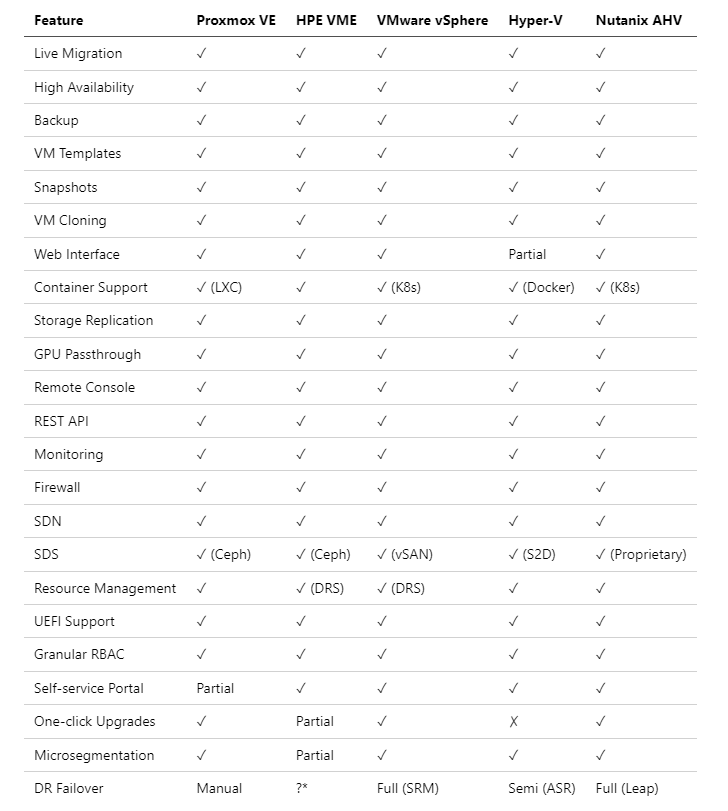Comparison of Virtualization Platforms: A Comprehensive Guide

Maximize effectivity
Proxmox Virtual Environment (Proxmox VE)
Key Advantages
Proxmox VE is a platform offering a complete HCI (Hyperconverged Infrastructure) solution that combines:
Fully integrated HCI solution: Virtualization (KVM hypervisor)Containerization (LXC)Software-defined Storage (Ceph, ZFS)Software-defined Networking
Low licensing costs while maintaining enterprise functionality
Intuitive web interface with advanced features
Integrated clustering and high availability
Live migration of virtual machines between nodes
Integrated backup system
Advanced storage replication and HA
Active community and commercial support availability
Typical Use Cases
Ideal for small and medium-sized businesses, hosting providers, and organizations that prefer cost-effective solutions with professional support.
VMware vSphere
Main Characteristics
Long-term market leader in enterprise virtualization
Robust feature set for enterprise environment management
Advanced high availability and disaster recovery features
Extensive ecosystem of add-ons and integrations
Professional enterprise-level support
Limitations
High licensing costs
Complex licensing model
Higher management and maintenance requirements
Typical Use Cases
Most suitable for large enterprise environments, particularly organizations requiring advanced automation and orchestration capabilities. Ideal choice for companies with multi-site infrastructure and environments with high service availability requirements.
Microsoft Hyper-V
Key Features
Tight integration with Windows Server
Strong Windows workload support
Included in Windows Server license
Azure integration
Specifics
Limited support for some Linux distributions
Less flexible than competing solutions
Most suitable for Windows-centric environments
Typical Use Cases
Particularly well-suited for organizations with predominantly Microsoft infrastructure and those planning hybrid cloud deployments with Azure. Best fit for medium and large enterprises with Windows-centric environments and organizations already using Microsoft System Center for management.
HPE VM Essentials
Key Advantages
HPE VM Essentials is a KVM-based solution with automated clustering that offers:
Automated HPE VME cluster deployment
Integrated CEPH storage configuration for multi-node clusters
DRS - automatic cluster load balancing
Advanced monitoring and management
Granular RBAC system
Integrated image library with automation stacks
UEFI support
Integrated VM backup and recovery
Typical Use Cases
Suitable for organizations using HPE hardware looking for enterprise solutions with advanced automation and integrated HCI.
Nutanix AHV (Acropolis Hypervisor)
Key Advantages
Nutanix AHV is an enterprise HCI solution built on KVM that offers:
Fully integrated HCI solution with proprietary hypervisor
Advanced automation and self-healing
One-click operations and upgrades
Prism Central for centralized multi-cluster management
Integrated disaster recovery
Microsegmentation and advanced networking features
Flow for network security
Files for integrated file services
Calm for automation and application orchestration
Typical Use Cases
Ideal for large organizations seeking comprehensive HCI solutions with emphasis on management simplicity and automation.
Detailed Feature Comparison

Explanation of Advanced Features:
Microsegmentation
Advanced network security feature allowing security policies at individual VM or application level:
VMware: NSX provides detailed network traffic control
Nutanix: Flow enables application-oriented segmentation
Hyper-V: SDN with Windows Server provides microsegmentation
HPE VME: Basic network isolation
Proxmox: Advanced firewall rules
One-click Upgrades
System's ability to perform complex environment-wide upgrades with a single click:
Nutanix: Fully automated stack upgrades
VMware: Automated upgrades via vSphere Update Manager
HPE VME: Partially automated upgrades
Proxmox: Integrated upgrade system
Hyper-V: Manual process with WSUS
Conclusion
When selecting a virtualization platform, several key factors need to be considered:
Organization's budget
Required support level
IT team's technical expertise
Specific functionality requirements
Long-term IT infrastructure strategy
HCI and automation requirements
Integration with existing infrastructure
Why Proxmox VE as optimal Choice for SME/SMB
Proxmox VE represents an exceptionally effective solution especially for small and medium-sized businesses:
Complete enterprise HCI functionality at a fraction of competitors' cost
Low acquisition and operational costs while maintaining professional support
Simple implementation and management
No hidden fees or complex licensing models
Full support for modern technologies (containers, SDN, SDS)
Active community and availability of local professional support
Ideal for: Companies looking to maximize IT investment returnsOrganizations seeking modern HCI solution without vendor lock-inCompanies preferring transparent pricing modelBusinesses with limited IT budget but high functionality requirements
Other Platforms
VMware vSphere: Suitable for large enterprise environments requiring advanced features
HPE VME: Optimal for organizations using HPE hardware
Hyper-V: Best choice for Windows-centric environments
Nutanix: Solution for organizations seeking comprehensive HCI with emphasis on management simplicity
For the SME/SMB segment, Proxmox VE proves to be an optimal solution, offering all key enterprise features without premium pricing. Through its combination of open-source approach and availability of professional support, it represents a sustainable and scalable solution.
